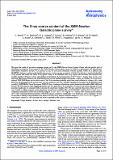Por favor, use este identificador para citar o enlazar a este item:
http://hdl.handle.net/10261/46856COMPARTIR / EXPORTAR:
 SHARE SHARE
 CORE
BASE CORE
BASE
|
|
| Visualizar otros formatos: MARC | Dublin Core | RDF | ORE | MODS | METS | DIDL | DATACITE | |

| Título: | The X-ray source content of the XMM-Newton Galactic plane survey |
Autor: | Motch, Christian; Warwick, R. S.; Cropper, M. S.; Carrera, Francisco J. CSIC ORCID CVN ; Guillout, P.; Pineau, François Xavier; Pakull, M. W.; Rosen, Simon; Schwope, Axel; Tedds, J. A.; Webb, Natalie A.; Negueruela, I.; Watson, Mike | Palabras clave: | X-ray binaries X-ray stars Surveys Binaries: close |
Fecha de publicación: | nov-2010 | Editor: | EDP Sciences | Citación: | Astronomy and Astrophysics 523: A92 (2010) | Resumen: | We report the results of an optical campaign carried out by the XMM-Newton Survey Science Centre with the specific goal of identifying the brightest X-ray sources in the XMM-Newton Galactic plane survey. In addition to photometric and spectroscopic observations obtained at the ESO-VLT and ESO-3.6 m, we used cross-correlations with the 2XMMi, USNO-B1.0, 2MASS, and GLIMPSE catalogues to advance the identification process. Active coronae account for 16 of the 30 positively or tentatively identified X-ray sources and exhibit the softest X-ray spectra. Many of the identified hard X-ray sources are associated with massive stars, possible members of binary systems and emitting at intermediate X-ray luminosities of 1032−34 erg s-1. Among these are (i) a very absorbed, likely hyper-luminous star with X-ray/optical spectra and luminosities comparable to those of η Carina; (ii) a new X-ray-selected WN8 Wolf-Rayet star in which most of the X-ray emission probably arises from wind collision in a binary; (iii) a new Be/X-ray star belonging to the growing class of γ-Cas analogues; and (iv) a possible supergiant X-ray binary of the kind discovered recently by INTEGRAL. One of the sources, XGPS-25, has a counterpart of moderate optical luminosity that exhibits HeII λ4686 and Bowen CIII-NIII emission lines, suggesting that this may be a quiescent or X-ray shielded low mass X-ray binary, although its X-ray properties might also be consistent with a rare kind of cataclysmic variable (CV). We also report the discovery of three new CVs, one of which is a likely magnetic system displaying strong X-ray variability. The soft (0.4–2.0 keV) band log N(>S) − log S curve is completely dominated by active stars in the flux range of 1 × 10-13 to 1 × 10-14 erg cm-2 s-1. Several active coronae are also detected above 2 keV suggesting that the population of RS CVn binaries contributes significantly to the hard X-ray source population. In total, we are able to identify a large fraction of the hard (2–10 keV) X-ray sources in the flux range of 1 × 10-12 to 1 × 10-13 erg cm-2 s-1 with Galactic objects at a rate consistent with what is expected for the Galactic contribution alone. | Versión del editor: | http://dx.doi.org/10.1051/0004-6361/200913570 | URI: | http://hdl.handle.net/10261/46856 | DOI: | 10.1051/0004-6361/200913570 | ISSN: | 0004-6361 | E-ISSN: | 1432-0746 |
| Aparece en las colecciones: | (IFCA) Artículos |
Ficheros en este ítem:
| Fichero | Descripción | Tamaño | Formato | |
|---|---|---|---|---|
| xraysurvey.pdf | 12,45 MB | Adobe PDF |  Visualizar/Abrir |
CORE Recommender
SCOPUSTM
Citations
30
checked on 22-abr-2024
WEB OF SCIENCETM
Citations
27
checked on 26-feb-2024
Page view(s)
349
checked on 21-may-2024
Download(s)
270
checked on 21-may-2024
Google ScholarTM
Check
Altmetric
Altmetric
NOTA: Los ítems de Digital.CSIC están protegidos por copyright, con todos los derechos reservados, a menos que se indique lo contrario.
